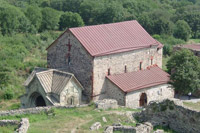Kvemo Kartli
Dmanisi

Dmanisi is a fortified town of Middle Ages. It is located in Kvemo Kartli, at the confluence of rivers Finezauri and Mashavera, 93 kilometers to the south-west from Tbilisi. In historical sources it was first mentioned in IX century while the town was under domination of Arabs and was ruled by Emir. The town used to be encircled by a high fence built from basalt stone and reinforced by abutment with entrance gates built in from south-west. Inside the fortress there is a three-nave Basilica - Dmanisi Sioni (VI c.) which was attached with richly ornamented gates during the reign of Giorgi IV Lasha. Fortress hosts also a church and a belfry from late feudal times. On the territory of the ruins were discovered: wide tunnel leading down to the river, shops (oil distillery, pottery), baths, encampments, cellars, mosque with a minaret, and madrasah. The dwellings of wealthy Dmanisi residents were decorated with color stones.
Major discoveries:
1983
Scientist discovered a tooth of a Plio-Pleistocene rhinoceros in the medieval pits of the Dmanisi town, demonstrating that the medieval site of Dmanisi covers the secrets of the early Pleistocene.
1984
First stone tools, indicating that Dmanisi is one of the oldest places of human occupation.
1991
Discovery of the first hominin remain in Dmanisi: the mandible D211 which reopened the debate about to the first human dispersal out of Africa.
1999
Recovery of the two hominin crania - D2280, D2282. These finds demonstrate that Dmanisi hominins are the oldest humans outside of Africa.
2000
Discovery of the mandible D2600, that raised the possibility of two different species at Dmanisi at the same time, as this mandible is unusally large.The mandible D2600 was found just above the Masavera basalt.
Absolute dating. Uneroded basaltic lava under site is securely dated to 1.85 million years ago.
2002
Discovery of the toothless hominin cranium, D3444, making a perfect fit with the toothless mandible. Its condition suggests it could only eat soft plants and animal foods with the help of other individuals.
2003
The first stone tool cutmarks were found on animal bone.
2007
Postcranial remains of four individuals, partly associated with crania found earlier.
2011
Earliest human occupations at Dmanisi (1.85 Ma), before the accumulation of the hominin fossil assemblage (1.77 Ma).
2013
Publication of the Skull5 in Science. Changing the perspectives on human evolutionary history.